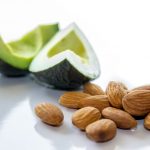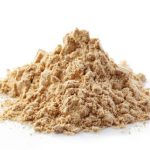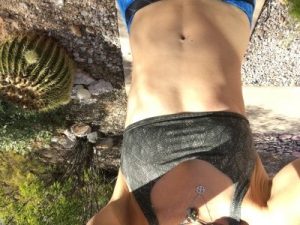Although I take pretty rigorous (and joyful!) care of myself and feel great (and feel like I look pretty good!) because of it, I admit I’ve had to work a little harder through my late 40s to fend off the creep of an expanding middle.
One of the body issues women lament most in this decade and beyond is what is sometimes unappealingly dubbed “menopot.” The long slow decline in levels of estrogen and progesterone (and possibly other hormones)—sometimes beginning as early as the mid-thirties, and increasing through perimenopause—is believed to be at least partly responsible for the shifting allocation of fat to the middle. Even when the cycle is still perfectly regular, hormonal fluctuations can have an influence. It’s so vexing for many women that I’ve joked with friends and colleagues that if we could crack this code, we’d have a real following. Well, I think I have a bead on it!

I myself did start to see changes in my middle starting around 46, so I began researching and fine-tuning to perfect the tweaks that can make the difference. This is what’s worked for me—and is still working!—and I’ve been very happy with the results.
And nice thing is, all these recs will be healthy and good for you in other ways regardless!
- Manage cortisol, which means manage stress. That involves good sleep, rest, and stress management (which must include meditation!). Cortisol is a steroid hormone produced by the adrenal glands. While cortisol has gotten a bad rap for causing belly fat and other negative symptoms when produced in chronic excess, it has many normal, healthy roles in the body.
Cortisol is released in response or stress (which can include exercise) and makes energy available to the body. In a healthy response, it ebbs when the stressor eases. But chronic stress can expose the body to consistently elevated cortisol levels, which is associated with abdominal fat gain as well as anxiety, cognitive issues, and compromised immunity.
Here’s what I notice: if I start consistently going to bed too late (as a lifelong true night owl, for me that’s after 1:00 a.m.) and not getting at least 8 hours of sleep, my middle mushes out a bit. And although I’m blessed to live a pretty low-stress life overall, of course stuff happens—and when it does, I not ice a change in the spare tire. After a car accident in 2013 that left my nervous system on high alert for weeks, I watched my waistline grow by an inch in one month, without any other changes in diet or exercise. Seriously.
ice a change in the spare tire. After a car accident in 2013 that left my nervous system on high alert for weeks, I watched my waistline grow by an inch in one month, without any other changes in diet or exercise. Seriously.
So what do I do? Get eight hours a night (8.5-9 is even better) and get to bed by what I know is my best bedtime (yours will vary). Daily meditation is essential (I do at least 20 minutes a day—my favorite program is here) and take herbs that help manage cortisol and adrenal stress (see #10 below).
- Keep strength training in the mix. Cardio is important, but muscle is the main engine in your body that burns fuel, including fat (more explanation here). Studies tend to show muscle mass declining with age, but keep in mind they are reporting what happens based on what “average” people do and don’t do—not how it necessarily has to be for you. Studies also show this decline can be mitigated with even a modicum of strength training.
Multiple bennies here: not only will you keep the metabolic fires burning and keep muscle mass up, but obviously you’ll also sculpt that muscle into nicer shapes and have the benefit of—hello!—being strong.
- Mix both long-slow and short-hard workouts—and include Tabata. Twice a week, I do a tabata run or bike, which is simply 20 seconds of all-out effort+ 10 seconds rest/easy effort x 8. Four minutes. You may have to wipe yourself off the ground after this four minutes, but you will feel triumphant that you did it and exhilarated by the results. The metabolic boost you’ll get from this well-studied, highly precise protocol is not to be underestimated. (This is a very intense workout, so make sure you are cleared health-wise for such effort.)

I also make sure to include both longer slower workouts and short intense ones (with intervals) in each week. There is science backing benefits of both. People often say to me “there’s new info every day, how do you know what to do? What’s the ‘right’ kind of exercise?” There IS no right kind of exercise; it depends on what you’re trying to achieve! And what you like, too, because that’s the kind you’ll do! Different training protocols yield different results—speed, muscle definition, endurance, strength, fat burning. Whatever you enjoy, it’s all good for something.
My strategy is to do a little of everything—for diversity of benefits, and to skirt boredom. I enjoy long slower bike rides and hikes for the outdoor time, nature connection, sunshine and fun—and I am still burning calories and building endurance. I do short hard workouts and high-intensity interval training (HIIT) for the many benefits we’re discovering they offer (and in this context, definitely for the fat-burning and metabolic boosts!).
If time is tight, just try to get two 10/15-min HIIT workouts in per week, one 4-minute tabata, and two longer (30 to 60 minutes) walks, hikes, or bike rides. Walking the dog counts and certainly is better for your belly than binge-watching Netflix reruns.
- Eat fats from healthy whole-food sources, not processed/refined oils. Nuts, seeds, olives, avocado. These are my fats. I rarely add oil to anything—maybe a teaspoon or half-T or less of walnut, avocado, algae or olive oil with some water for stirfrying or sautéing veggies—that’s it. I don’t adore avocados (heresy for a plant-based gal, I know!) but I try to sneak them in (guac works, also in smoothies).
Yes, “eat more fat to get lean” vs. “the fat on your lips is the fat on your hips” is an area of disagreement right now, even among favorite plant-based and functional medicine docs. You may want to experiment to see what works best for you. I believe that your constitutional body type will affect your needs more than is usually considered in Western approaches (in Ayurveda, vata or air type needs/tolerates more fat than kapha or earth type, for example).
even among favorite plant-based and functional medicine docs. You may want to experiment to see what works best for you. I believe that your constitutional body type will affect your needs more than is usually considered in Western approaches (in Ayurveda, vata or air type needs/tolerates more fat than kapha or earth type, for example).
My own experience is that our knowledge about the importance of healthy fats is not license for most of us to gorge on it. I do get plenty of fat from food (according to MyFitnessPal, average 70 grams a day) but I find if I add a lot of oil, or load up on high-fat foods, I do end up with more fat around my middle. Again, do what works for you—but for sure stick to whole-food sources as much as possible.
- Hydrate. I drink a gallon a day. That’s right. And not just because I live in the desert. Get dehydrated and you’ll actually start holding on to water, bloating yourself up. While water gain is not fat gain (which is one of many reasons your weight is such a meaningless number), it doesn’t help you feel like you’re making progress. Hydrating also keeps you feeling appropriately full, not to mention good hydration makes for glowing skin.
- Sleep. Not only does too little sleep raise cortisol, but it also boosts the hormone grehlin, which makes you hungry, which can lead to food choices you might not otherwise make (have you ever felt like your body was trying to compensate for an all-nighter by using food instead of sleep to keep you going?) Get 7, 8 or even 9 hours a night. Don’t get less than 7, period. It’s not helping your middle and it’s also not helping anything else, either. You know this!
- Break up the sitting and move all day long. This one is huge. Sitting all day gives me a bigger belly, period. Try to move as much as you can all day long even when you’re not officially “exercising.” If you don’t have a manual labor job or a job that requires standing, this takes concerted effort, but it’s worth it. I’m so guilty of getting on a roll in front of the computer (such as while writing this!) and not moving for hours.
 Set an alarm and get up every half hour and move around. Every time you get up to go to the bathroom (or fridge)! do 10 or 15 jump squats, step-ups, pushups, mountain climbers, skaters, high knees, step-ups, or burpees. Do that 10 times a day and you’ve squeezed 100-150 plyo or bodyweight moves into your day—woot!
Set an alarm and get up every half hour and move around. Every time you get up to go to the bathroom (or fridge)! do 10 or 15 jump squats, step-ups, pushups, mountain climbers, skaters, high knees, step-ups, or burpees. Do that 10 times a day and you’ve squeezed 100-150 plyo or bodyweight moves into your day—woot!
Also, stand at the computer sometimes (I have a sitting and standing station, and I switch back and forth all day long).
- Be cold sometimes. Look, I probably hate it more than you do. I moved to Arizona for the weather, not the politics! But being cold may have metabolic benefits. It may cause the body to produce, or to activate, brown fat that burns more calories to keep you warm. So even though I don’t like it, in winter I sleep with the heat off, and I make myself tolerate a cold house for an hour every morning. And when it’s warm/hot, in spring and summer, I force myself to take a couple of cold showers a week, and swim in a cold pool. Like many of these tips, it’s not a plan by itself, but all of these little boosts may be cumulative. My belly is never flatter than when I spend two months every fall in Seattle—and I attribute that to the chilly house I stay in (plus the stairs in that house—see previous tip!)
- Take herbs. As foremost herbalist KP Khalsa and I wrote in our book Herbal Defense, modern life is such that most of us need support beyond the basics—and natural medicines (what KP
 sometimes calls “Grandma Medicine”—are a key element in that support. There are so many “minuses” in our environment that we have to add pluses to balance the columns—and that includes herbs, which in other cultures are as much a part of the fabric of daily life as food.
sometimes calls “Grandma Medicine”—are a key element in that support. There are so many “minuses” in our environment that we have to add pluses to balance the columns—and that includes herbs, which in other cultures are as much a part of the fabric of daily life as food.
On the belly fat front, for me this means holy basil and ashwaghanda—tonics or adaptogens revered in the herbal world that are believed to temper cortisol as well as support the thyroid. Shatavari and chaste berry are two herbs I take to help regulate hormones (the Chinese herb dong quai does a similar job but is more warming in the Ayurvedic or Chinese, while shatavari is “cool”).
Since my thyroid tests at the low end of normal, I support my thyroid as well, with a iodine product called Iodoral and with tyrosine and the ashwaghanda mentioned above. If you think your thyroid might be a bit sluggish (symptoms listed here), get tested—and make sure you get a full panel, not just TSH but free T3, free T4, and thyroid antibodies. Your may not be considered hypothyroid enough to require meds, but supplements may help if you are subclinical/sub-optimal. See a qualified functional medicine doc and/or natural medicine practitioner for specific recs based on your situation.
(NOTE: These statements have not been evaluated by the FDA and I am not a licensed medical professional. Check with your health practitioner regarding any supplements and possible interactions with drugs.)
- Limit sugar. I love my sweets, but I’ve trained my body to love less of it, and I’m super choosy about which ones I’ll indulge in. It can be done! I was limiting my grams of sugar to 50 or below per day long before the government recommended it in 2105—and I still enjoy chocolate, cocoa, fruit, granola, even a cookie or two almost every day. It’s all in smart, conscious choices. (Check out my tip-filled post on how to keep sugar below 50 grams.) Sugar will definitely inflate that tire, so be

February 2016 smart and you can still enjoy sweets and make them count. (For one example: I love chocolate and eat it every day; I just make sure it’s 85% cacao or darker, and limit to about 6-7 squares, or 1.5 ounces/ish.)
- Add spice whenever you can. This isn’t some huge antidote in and of itself, but in the spirit of “every little bit helps”: I try to add cayenne and chili powder to every recipe I can. My cocoa is always Mexican, I like chai rooibos teas and Republic of Tea’s “Get Burning” (with ginger, black pepper, and chili powder as well as holy basil and cordyceps) and spicy soups. If I bake cookies or cake, I’ll usually make them spicy too! Because in Ayurvedic terms I am pitta (fire type) and don’t do well with a constant influx of hot and spicy foods, I limit spices like cayenne and chilies to a few times a week, but ginger works well for inflammation.
- Drink green tea. While I’m more of a rooibos gal (and I rarely drink caffeine—that’s right, none of these tips include revving up with caffeine, although you can if you want!) I make sure to drink at least a cup of green or white decaf every day. It’s not for the caffeine—it’s for the polyphenols (green tea’s polyphenols are called catechins). While studies are not definitive, green tea may boost metabolism and help regulate blood sugar, and research suggests many other benefits too, so it doesn’t hurt to add it in. One of my favorite teas is a “green chai” with one bag of decaf green and one bag of chai rooibos. Green, spicy and delicious! (NOTE: Decaf green and white teas do appear to have less antioxidant content due to the decaffeination process. If you can handle the caffeine, to get all the benefits you’ll want non-decaf teas. A 2018 update—I am now drinking small amounts of caffeinated green and white tea, sparingly and judiciously, and tolerating this well despite my sensitivity to caffeine.)
- Do hard, smart (not long!) abs/core workouts. You can’t spot-reduce fat (will that myth EVER die?!), but it’s sure nice, when all the other tips are working, to have at least an incipient four-pack peeking through. The fun of that inspires me to crunch, plank, and otherwise burn out my core a couple days a week to strengthen and tone my abdominals and obliques. A strong core also benefits you in countless ways beyond appearance, and I honestly get as much of an endorphin hit from these workouts as I do from a run, hike or bike ride. Try it!

October 2015. Some of my favorites include Bowflex’s really short 6- to 8-minute workouts, FitnessBlender’s 10- and 8-minute abs workouts (I string two back to back), and BeFit’s Power Abs with Nicola Harrington (the gal’s had three kids, so chew on that). I also like trainer Danielle Pascente’s 30-Day Fat Burn workouts—12 or so HIIT routines that always incorporate core moves. As a trainer I can and do invent my own routines for myself and others, but it’s fun for me to be “coached” myself through solid quality workouts. If you’re not in shape yet to do a tough floor routine for your abs, treading water in a pool can provide a good gentle core workout. When you’re ready, choose a quality, well-cued video or get the support of a personal trainer to show you the most effective moves safely.
- Eat a generally anti-inflammatory diet. Some people like to follow specialized anti-inflammatory diets. That’s fine, but in truth the same general eating style that’s most proven and recommended for prevention of virtually every major illness—by volumes of research—happens to be naturally anti-inflammatory. If you have serious inflammation issues you may want to research and try eating or eliminating specific foods (and you may want the help of a functional medicine doctor). But in general, barring unique sensitivities, you’ll be ahead of the game eating a whole-food plant-based diet, greatly limiting processed foods, limiting sugar, limiting grains (and eliminating refined grains), limiting or eliminating meats and dairy, and definitely eliminating chemicals and synthetics. (Watch for artificial colors/flavors and preservatives, and go organic whenever possible.)

If you do this, you’ll automatically be eating lots of veggies, some fruits, nuts, seeds, legumes, beans, and a modest amount of whole/diverse grains, with fats from the healthiest sources. That’s what I do (with a generous daily helping of very dark chocolate and/or cocoa!). You’ll keep inflammation at bay—and if you believe the mother lode of studies, you’ll be boosting your odds against dozens of the most feared diseases while you’re at it.
- Take a probiotic. This is another recommendation in the realm of “it has many other benefits as well, so it’s a good idea regardless.” Gut health is inextricably linked to whole health, and many natural healing practitioners believe that compromised intestinal flora plays a role in a host of health issues (possibly even metabolic syndrome). At very least, gas, bloating, constipation and other intestinal discomforts can make your belly seem to stick out (and anyway, they’re no fun). As with water retention, this is not the same as functionally being fatter around the waist, but it can be discouraging. Improving digestion and the health of your microbiome is not something you can go wrong doing.
I’m a huge believer in “it’s never just one thing”—there is no one magic bullet. An integrated, holistic approach, starting with broadly proven basics and fine-tuning from there, is what creates a radically, radiantly healthy life. It’s the way I approach my own life as well as writing, teaching and coaching. There are no shortcuts—a healthy body comes from a healthy life, and a healthy life is multifaceted.
But is that so hard? I certainly don’t think so. Who needs shortcuts when the whole package can be so

fulfilling? Why would you want to shortchange your self-care and nurturing? I eat lots of foods I love every day, I get to move my body (which is an exhilarating privilege)—and I get to not only feel terrific, but keep in shape enough that I get to be a fairly “old” fitness model!
The basics of truly clean eating, and varied movement with adequate recovery, are the foundations for a strong and lean body. But stepping up your game in these specific ways can help trim that last stubborn bit of bicycle tire from your middle, even when basics aren’t cutting it. If I see a bit of creep, doubling down on these healthy practices whittles things down within a month. (No, not overnight. Let’s be real! But so what? What’s a month, really? What’s a year for that matter? Certainly comes a lot sooner than…never!)
Best of all? Every one of these things has health benefits way beyond how your tum looks (funny how that works, right?), so no reason not to try!